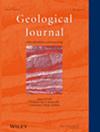In Situ LA-ICP-MSU-Pb Dating and Trace Element Analyses of Wolframites From the Guomuyang Tungsten Deposit in Fujian Province, China
Abstract
In situ LA-ICP-MS U–Pb dating and trace element analyses were conducted on the wolframites present in the quartz veinlets and large quartz veins of the ores within the Guomuyang tungsten deposit in Fujian. The results of the U–Pb dating indicate that the ages of the wolframite samples sourced from the quartz veinlets and large quartz veins are 109 Ma and 107–105 Ma, respectively. The timing of tungsten mineralization in the deposit coincides with the stages of tungsten mineralization in the Nanling area, suggesting that the large-scale tungsten mineralization in South China during the Early Cretaceous might have extended eastward from the Nanling area to the Wuyishan metallogenic belt. The wolframite in the quartz veinlets has relatively high concentrations of Nb and Ta and a low δEu value, indicating that the early quartz veinlets containing wolframite were formed under relatively reductive conditions. In addition, the non-characteristic features of the Y/Ho and Zr/Hf ratios of wolframite suggest that F might have played an important role in the migration and enrichment of tungsten. Through detailed morphological observations of the orebodies and analyses of the mineral assemblages, and in combination with the prominent geochemical characteristics of wolframite, which exhibit significant enrichment of heavy rare earth elements, as well as being poor in La and Ce while rich in Y, it is concluded that the genetic type of the Guomuyang tungsten deposit belongs to the magmatic-hydrothermal type tungsten deposit.


 求助内容:
求助内容: 应助结果提醒方式:
应助结果提醒方式:


